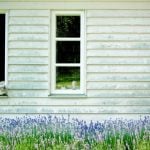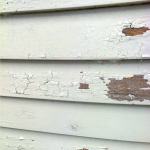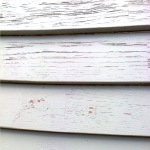Repainting Old Timber Weatherboards
In the 1960s and 70s the preferred finishing system for the exterior of weatherboard homes moved from mineral turpentine thinned oil based paints to water thinned acrylic paints. These two types of paint are very different in their mode of weathering and the preparation required when the time comes to repaint.

Oil based paints get progressively harder and more brittle as they age. Repainting the weatherboards over time results in a build up of paint which can reach a point where the weight of paint causes failure of the coating system at the weakest point. It has been some 40 years since maintenance practices for houses finished in oil based paints was needed, so knowledge of these practices has, to a large degree, been lost. When painting weatherboard houses with oil based paints was the norm it was usual to repaint a house every 5 years. It was common practice to repaint one wall of the house every summer, so that in year 5 the first wall to be painted in the rotation sequence received it’s repaint.
After 5 repaints, that is 25 years, it was good painting practice to remove the old build up of paint, usually by burning-off back to the bare timber, and the whole process would start again. Weatherboards were always finished in a gloss light colour as oil based paints in a low sheen or in a dark colour did not last. Stripping, either by burning, sanding, scraping or with solvent, of old paint on a weatherboard house is an expensive, labour intensive, dirty and hazardous process. Owners unable or unwilling to pay the price of a complete strip would opt to remove only the most obvious areas of failure, sand the surface, spot prime any bare areas and repaint. The home owner taking that option recognised that the consequence of that choice was patchy early failure of the coating. If they wished their house to maintain its good appearance these owners spent, or paid a painter to spend, each summer repairing areas of coating failure.
Water thinned Acrylic paints retain flexibility throughout their life. As they weather they slowly erode away. Once the acrylic paint has eroded to the point that only half a coat of paint remained on the surface a repaint is needed. Repainting then consists of cleaning the surface down and replacing the paint that has eroded away by applying 2 coats of new Acrylic Paint. There is no build up of coating to remove. Premium Acrylic paints last up to 15 years for light colours, up to 10 years for dark colours. The durability of an acrylic paint is not markedly reduced by using a lower gloss version. Now the homeowner is able to paint their house in any colour and sheen level.
Gloss paints, both oil based and water based, are around 50% volume Solids. As they dry they shrink to half their applied thickness and tighten on the surface to which they have been applied. This causes stress on any aged paint film to which they have been applied and can result in early failure of paint applied over a seemingly sound build up of aged coats of oil based paint.
Fashionably dark colours cause large changes in the surface temperature of any repainted weatherboard exposed to direct sunlight. This causes significant movement of the weatherboard which can shatter underlying aged oil based paint resulting in early failure.
Up till the 1960s the most common timber weatherboard in parts of New Zealand was Totara. Totara contains natural oils that prevent the curing of oil based paint. An especially formulated Totara Primer used to be applied to bare Totara to prevent this from happening. Though they enabled the painter to successfully coat Totara, these primers had the disadvantage that they were harder and more brittle than standard oil based primers or finish coats. There are a significant number of homes throughout New Zealand with Totara weatherboards that have aged, with very brittle Totara primer and numerous top coats of aging brittle oil based paints still on them. If these weatherboards are repainted without first stripping the old paint off, they are likely to show early failure of the paint system applied.
These pictures show the north wall of a Totara weatherboard House that had been repainted with two coats of a light coloured Premium Semigloss Acrylic over an apparently sound coating. After three years weathering the walls of this house showed dramatic failure of the old oil based paint. Flakes of paint from this house showed at least 10 distinctly coloured coats of paint, including the original Totara Primer.


In all cases the Premium Semigloss Acrylic adhered tightly to the coat of paint to which it had been applied. Failure was at the most brittle point – that of the Totara primer. Either by adhesive failure, the primer was no longer stuck to the timber; or cohesive failure, the primer split so that there was primer on the flake and the weatherboard.
Conclusion:
If you want a failure free finish on a weatherboard house that is more than 40 years old – strip the paint on the weatherboards back to bare timber, re-prime with Protective Paints 8310-100 Duralon Alkyd Undercoat and apply two coats of Protective Paints premium acrylic paint, such as A119 House Paint, A096 Duraglo or A103 Duragard in your chosen colour.
NOTE: If the weatherboards are Totara, particularly heart Totara, the dry time of 8310-100 Duralon Alkyd Undercoat may be inhibited. In such cases A102-00 Duralon Acrylic Primer Undercoat is preferred, but ensure the weatherboards are well sanded to ensure adequate adhesion to the Totara timber. If this process is not followed then early failure of the paint system is likely to occur.
WARNING
Undercoats containing white lead were still being used until the mid 1970s. Prior to 1960 most white enamel paints contained white lead.
When repainting old houses with a build up of aged oil based paint test the old paint for lead. If lead is found, follow OSH recommended working practices.
Refer https://worksafe.govt.nz for further information and for a downloadable “Guideline for the Management of Lead Based Paint.”

Hello,
Thank you for your excellent and informative site. Your site is the first one of its kind to answer questions which have been asked by me of numerous paint distributors and painters and never fully explained in the detail to which you’ve provided. Although not a professional painter, I’ve done some painting and aim to get the best results I can and also have an understanding if things don’t go plan. Your information on oil based paints for external weatherboards was particularly useful. Thanks, Vera
Thanks Vera, glad you found it informative.
Appreciate it for all your efforts that you have put in this. very interesting information.
Like Vera above, I am relieved and pleased to read this information. I have also asked for advice from all sources over the years and then had to take a punt on how to proceed. We built our own house in 1974 and clad it in pre-primed, finger-jointed pine weatherboard, the popular option at the time. I have refurbished the paint (26 walls) over the years using oil paint in early years and acrylic for the last 20-25 years. Now, on the direct sun-facing walls, the paint is failing right back to the pink primer. All other walls are OK.
I am a retired school teacher aged 73. We elect to do our own home maintenance and keep our savings for enjoyable pursuits. Painting one wall takes days of effort, so I want and need to proceed in the best way. I’ll be calling these professionals tomorrow for advice.
BRILLIANTLY informative, the best advertisement for your product as it shows the company knows their products
CONGRATULATIONS